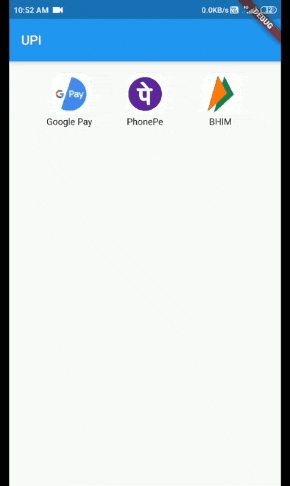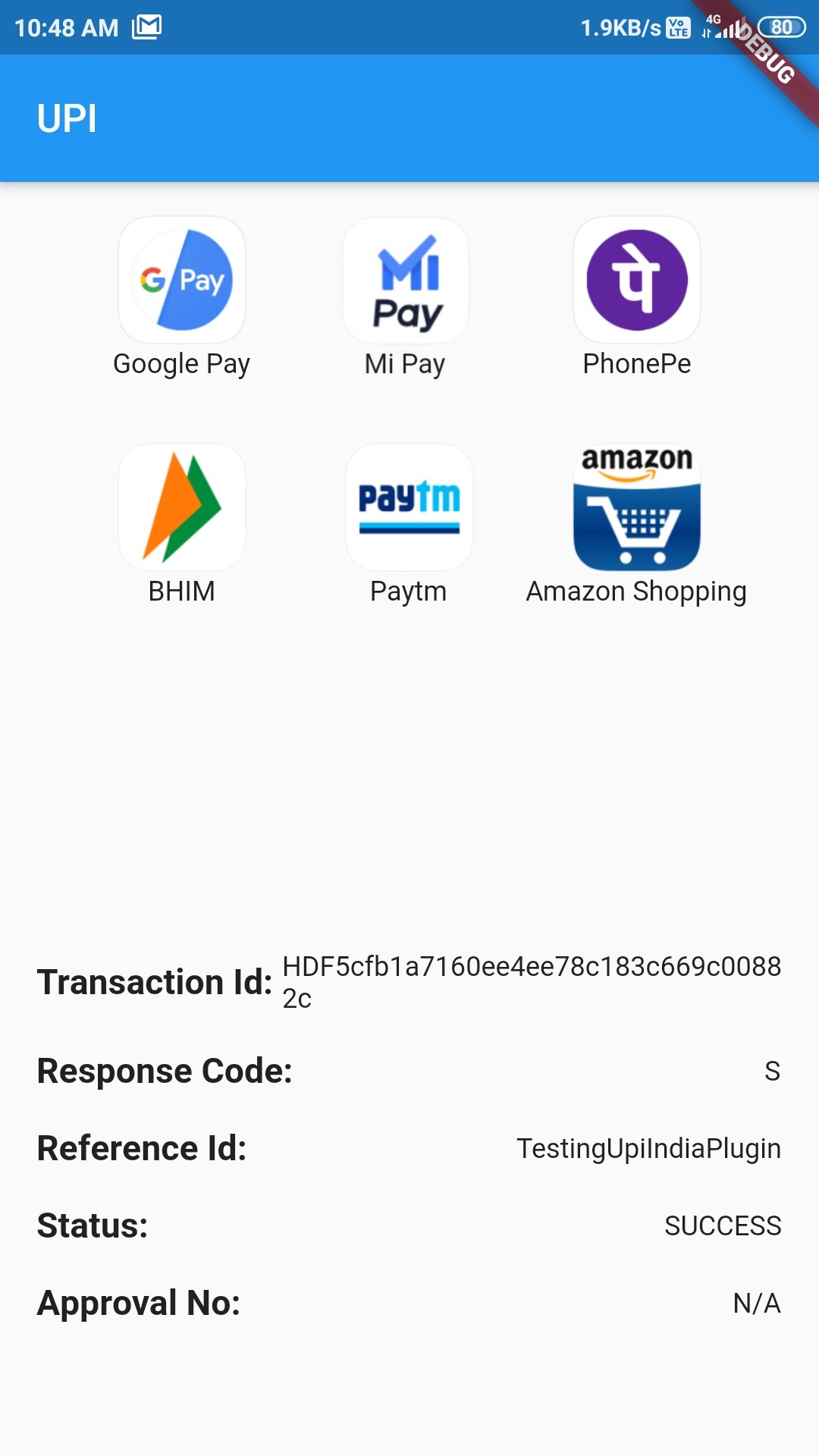Flutter印度统一支付接口插件upi_india的使用
Flutter印度统一支付接口插件upi_india的使用
UPI India (仅限Android)
此插件用于在您的Android应用程序中集成UPI选项。您可以使用此插件向任何UPI ID或账户号码发起交易。


重要提示!
一些应用如Google Pay、PhonePe、Paytm目前无法处理交易,显示“最大限额已超过”或“风险阈值已超过”的错误。原因尚不清楚。
需要帮助
如果您可以帮忙将此插件扩展到iOS,请查看此问题。 如果您可以帮助验证不同UPI应用的兼容性,请查看此问题。
感谢您!:)
主要类介绍
-
UpiIndia
- 包含两个方法:
getAllUpiApps():获取所有支持UPI的应用列表- 参数:
bool allowNonVerifiedApps:是否包含未验证的应用List<UpiApp> includeOnly:仅显示这些应用并隐藏其他应用bool mandatoryTransactionId:是否包含不返回交易ID的应用
- 参数:
startTransaction():启动交易- 参数:
double amount:转账金额(以卢比计)UpiApp app:使用的应用String currency:目前仅支持INRbool flexibleAmount:允许用户填写金额String merchantId:商家代码(如果有)String receiverId:收款人IDString receiverName:收款人姓名String transactionNote:交易备注String transactionRefId:交易参考IDString url:额外信息
- 参数:
- 包含两个方法:
-
UpiApp
- 包含支持的应用,并作为
getAllUpiApps()返回的应用模型类。
- 包含支持的应用,并作为
-
UpiResponse
- 用于获取请求应用的响应。
-
UpiPaymentStatus
- 用于检查交易是否成功。
自定义异常
UpiIndiaAppNotInstalledExceptionUpiIndiaUserCancelledExceptionUpiIndiaNullResponseExceptionUpiIndiaInvalidParametersExceptionUpiIndiaActivityMissingExceptionUpiIndiaAppsGetException
如何开始交易?
步骤1:导入包
import 'package:upi_india/upi_india.dart';
步骤2:创建UpiIndia对象
UpiIndia _upiIndia = UpiIndia();
步骤3:获取设备上所有支持UPI的应用列表
List<UpiApp>? apps;
@override
void initState() {
_upiIndia.getAllUpiApps(mandatoryTransactionId: false).then((value) {
setState(() {
apps = value;
});
}).catchError((e) {
apps = [];
});
super.initState();
}
或者直接使用预定义的应用:
UpiApp app = UpiApp.googlePay;
步骤4:创建启动交易的方法
Future<UpiResponse> initiateTransaction(UpiApp app) async {
return _upiIndia.startTransaction(
app: app,
receiverUpiId: "9078600498@ybl",
receiverName: 'Md Azharuddin',
transactionRefId: 'TestingUpiIndiaPlugin',
transactionNote: 'Not actual. Just an example.',
amount: 1.00,
);
}
步骤5:调用此方法以启动交易
如何处理响应?
步骤1:检查是否有错误
if (snapshot.hasError) {
switch (snapshot.error.runtimeType) {
case UpiIndiaAppNotInstalledException:
print("Requested app not installed on device");
break;
case UpiIndiaUserCancelledException:
print("You cancelled the transaction");
break;
case UpiIndiaNullResponseException:
print("Requested app didn't return any response");
break;
case UpiIndiaInvalidParametersException:
print("Requested app cannot handle the transaction");
break;
default:
print("An Unknown error has occurred");
break;
}
}
步骤2:从snapshot.data中获取UpiResponse并提取参数
- 交易ID
- 响应码
- 批准参考号
- 交易参考ID
- 状态
步骤3:检查状态属性
UpiPaymentStatus.SUCCESSUpiPaymentStatus.SUBMITTEDUpiPaymentStatus.FAILURE
如果状态为SUCCESS,恭喜你!你已经成功使用了这个插件。
支持的应用
已验证的应用
- All Bank
- Amazon Pay
- Axis Pay
- Baroda Pay
- BHIM
- Cent UPI
- Cointab
- Corp UPI
- DCB UPI
- Fino BPay
- Freecharge
- Google Pay
- iMobile ICICI
- Indus Pay
- Khaali Jeb
- Maha UPI
- Mobikwik
- Oriental Pay
- Paytm
- Paywiz
- PhonePe
- PSB
- SBI Pay
- Yes Pay
不返回交易ID的应用(需设置mandatoryTransactionId: false)
- MiPay(Play Store和GetApps版本)
- HSBC Simply Pay
未验证的应用(需设置allowNonVerifiedApps: true)
- True Caller
- BOI UPI
- CSB UPI
- CUB UPI
- digibank
- Equitas UPI
- Kotak
- PayZapp
- PNB
- RBL Pay
- realme PaySa
- United UPI Pay
- Vijaya UPI
不支持的应用
- Airtel Thanks
- AUPay
- Bandhan Bank UPI
- CANDI
- Indian Bank UPI
- Jet Pay
- KBL UPI
- KVB UPI
- LVB UPAAY
- Synd UPI
- UCO UPI
- Ultra Cash
完整示例代码
import 'package:flutter/material.dart';
import 'package:upi_india/upi_india.dart';
void main() => runApp(MyApp());
class MyApp extends StatelessWidget {
@override
Widget build(BuildContext context) {
return MaterialApp(
title: 'Test UPI',
home: HomePage(),
);
}
}
class HomePage extends StatefulWidget {
@override
_HomePageState createState() => _HomePageState();
}
class _HomePageState extends State<HomePage> {
Future<UpiResponse>? _transaction;
UpiIndia _upiIndia = UpiIndia();
List<UpiApp>? apps;
TextStyle header = TextStyle(
fontSize: 18,
fontWeight: FontWeight.bold,
);
TextStyle value = TextStyle(
fontWeight: FontWeight.w400,
fontSize: 14,
);
@override
void initState() {
_upiIndia.getAllUpiApps(mandatoryTransactionId: false).then((value) {
setState(() {
apps = value;
});
}).catchError((e) {
apps = [];
});
super.initState();
}
Future<UpiResponse> initiateTransaction(UpiApp app) async {
return _upiIndia.startTransaction(
app: app,
receiverUpiId: "9078600498@ybl",
receiverName: 'Md Azharuddin',
transactionRefId: 'TestingUpiIndiaPlugin',
transactionNote: 'Not actual. Just an example.',
amount: 1.00,
);
}
Widget displayUpiApps() {
if (apps == null)
return Center(child: CircularProgressIndicator());
else if (apps!.length == 0)
return Center(
child: Text(
"No apps found to handle transaction.",
style: header,
),
);
else
return Align(
alignment: Alignment.topCenter,
child: SingleChildScrollView(
physics: BouncingScrollPhysics(),
child: Wrap(
children: apps!.map<Widget>((UpiApp app) {
return GestureDetector(
onTap: () {
_transaction = initiateTransaction(app);
setState(() {});
},
child: Container(
height: 100,
width: 100,
child: Column(
mainAxisSize: MainAxisSize.min,
mainAxisAlignment: MainAxisAlignment.center,
children: <Widget>[
Image.memory(
app.icon,
height: 60,
width: 60,
),
Text(app.name),
],
),
),
);
}).toList(),
),
),
);
}
String _upiErrorHandler(error) {
switch (error) {
case UpiIndiaAppNotInstalledException:
return 'Requested app not installed on device';
case UpiIndiaUserCancelledException:
return 'You cancelled the transaction';
case UpiIndiaNullResponseException:
return 'Requested app didn\'t return any response';
case UpiIndiaInvalidParametersException:
return 'Requested app cannot handle the transaction';
default:
return 'An Unknown error has occurred';
}
}
void _checkTxnStatus(String status) {
switch (status) {
case UpiPaymentStatus.SUCCESS:
print('Transaction Successful');
break;
case UpiPaymentStatus.SUBMITTED:
print('Transaction Submitted');
break;
case UpiPaymentStatus.FAILURE:
print('Transaction Failed');
break;
default:
print('Received an Unknown transaction status');
}
}
Widget displayTransactionData(title, body) {
return Padding(
padding: const EdgeInsets.all(8.0),
child: Row(
mainAxisAlignment: MainAxisAlignment.spaceBetween,
children: [
Text("$title: ", style: header),
Flexible(
child: Text(
body,
style: value,
)),
],
),
);
}
@override
Widget build(BuildContext context) {
return Scaffold(
appBar: AppBar(
title: Text('UPI'),
),
body: Column(
children: <Widget>[
Expanded(
child: displayUpiApps(),
),
Expanded(
child: FutureBuilder(
future: _transaction,
builder: (BuildContext context, AsyncSnapshot<UpiResponse> snapshot) {
if (snapshot.connectionState == ConnectionState.done) {
if (snapshot.hasError) {
return Center(
child: Text(
_upiErrorHandler(snapshot.error.runtimeType),
style: header,
), // Print's text message on screen
);
}
// If we have data then definitely we will have UpiResponse.
// It cannot be null
UpiResponse _upiResponse = snapshot.data!;
// Data in UpiResponse can be null. Check before printing
String txnId = _upiResponse.transactionId ?? 'N/A';
String resCode = _upiResponse.responseCode ?? 'N/A';
String txnRef = _upiResponse.transactionRefId ?? 'N/A';
String status = _upiResponse.status ?? 'N/A';
String approvalRef = _upiResponse.approvalRefNo ?? 'N/A';
_checkTxnStatus(status);
return Padding(
padding: const EdgeInsets.all(8.0),
child: Column(
mainAxisAlignment: MainAxisAlignment.center,
children: <Widget>[
displayTransactionData('Transaction Id', txnId),
displayTransactionData('Response Code', resCode),
displayTransactionData('Reference Id', txnRef),
displayTransactionData('Status', status.toUpperCase()),
displayTransactionData('Approval No', approvalRef),
],
),
);
} else
return Center(
child: Text(''),
);
},
),
)
],
),
);
}
}
希望这篇文档对你有帮助!如果你有任何问题或需要进一步的帮助,请随时提问。
更多关于Flutter印度统一支付接口插件upi_india的使用的实战系列教程也可以访问 https://www.itying.com/category-92-b0.html
更多关于Flutter印度统一支付接口插件upi_india的使用的实战系列教程也可以访问 https://www.itying.com/category-92-b0.html
关于Flutter中印度统一支付接口(UPI)插件upi_india的使用,下面是一个基本的代码示例,展示如何在Flutter应用中集成和使用该插件。请注意,由于具体的插件实现和API可能会随时间变化,以下代码仅供参考,并假设upi_india插件已经按照Flutter插件的标准方式集成到你的项目中。
1. 添加依赖
首先,确保在你的pubspec.yaml文件中添加了upi_india插件的依赖:
dependencies:
flutter:
sdk: flutter
upi_india: ^最新版本号 # 请替换为实际的最新版本号
然后运行flutter pub get来安装依赖。
2. 导入插件
在你的Dart文件中(例如main.dart),导入插件:
import 'package:flutter/material.dart';
import 'package:upi_india/upi_india.dart';
3. 初始化插件
在适当的时机(例如应用启动时)初始化插件。这通常是在State的initState方法中,或者如果你使用的是GetX、Provider等状态管理库,则在相应的初始化逻辑中。
void initUpiPlugin() async {
try {
await UpiIndia.initialize();
print("UPI plugin initialized successfully");
} catch (e) {
print("Failed to initialize UPI plugin: $e");
}
}
4. 发起支付请求
使用插件提供的API来发起支付请求。以下是一个简化的示例,展示如何调用支付功能:
void makePayment() async {
try {
String upiId = "your_upi_id@upi"; // 替换为实际的UPI ID
double amount = 100.0; // 支付金额
String note = "Payment for goods"; // 可选的支付备注
UpiPaymentResponse response = await UpiIndia.pay(
upiId: upiId,
amount: amount,
note: note,
);
if (response.status == "SUCCESS") {
print("Payment successful: ${response.transactionId}");
// 处理支付成功逻辑
} else {
print("Payment failed: ${response.errorMessage}");
// 处理支付失败逻辑
}
} catch (e) {
print("An error occurred during payment: $e");
}
}
5. 在UI中调用支付功能
最后,在你的UI中添加一个按钮来触发支付功能:
void main() => runApp(MyApp());
class MyApp extends StatelessWidget {
@override
Widget build(BuildContext context) {
return MaterialApp(
home: Scaffold(
appBar: AppBar(
title: Text('UPI Payment Example'),
),
body: Center(
child: ElevatedButton(
onPressed: () async {
await initUpiPlugin(); // 确保插件已初始化
makePayment();
},
child: Text('Make Payment'),
),
),
),
);
}
}
注意事项
- 权限:确保你的Android和iOS项目已经配置了必要的权限,以访问支付相关的功能。
- 安全性:不要在客户端硬编码敏感信息,如API密钥或支付密码。这些信息应该通过安全的方式(如服务器端生成)传递给客户端。
- 错误处理:在实际应用中,应该添加更详细的错误处理和用户反馈机制。
- 测试:在发布前,确保在多种设备和网络环境下充分测试支付功能。
由于upi_india插件的具体实现和API可能会变化,请参考插件的官方文档和示例代码以获取最新的使用指南。








